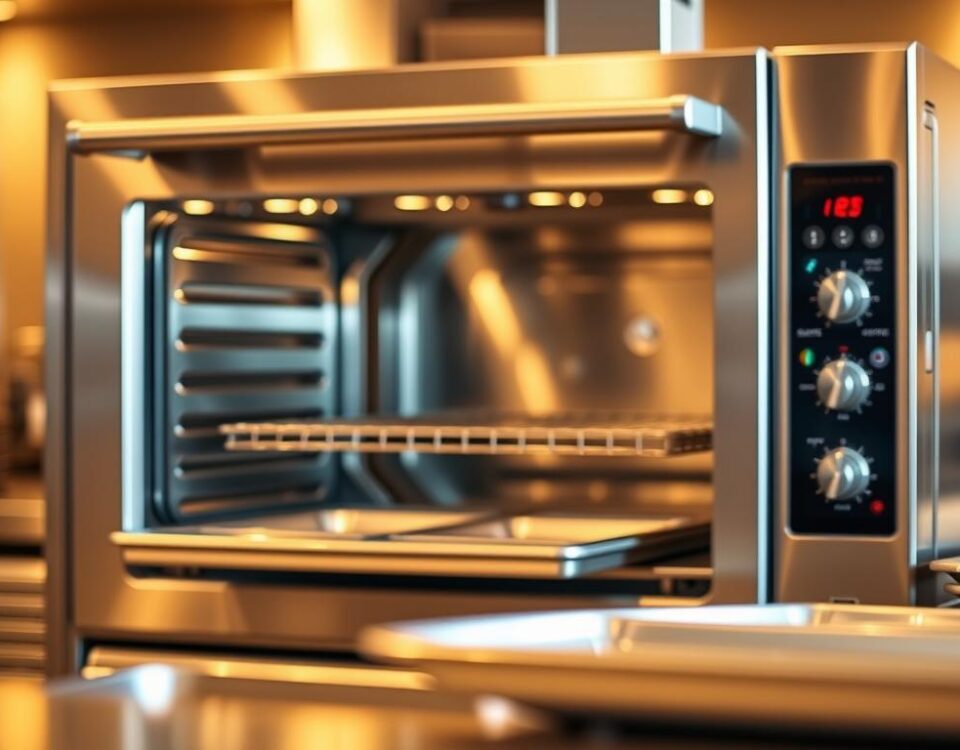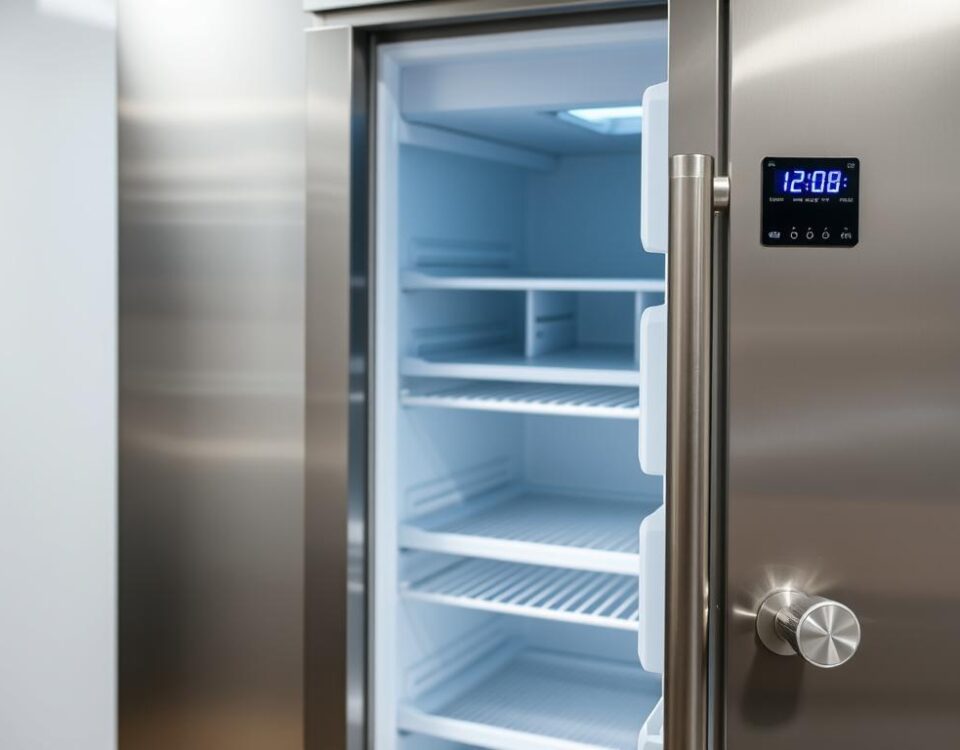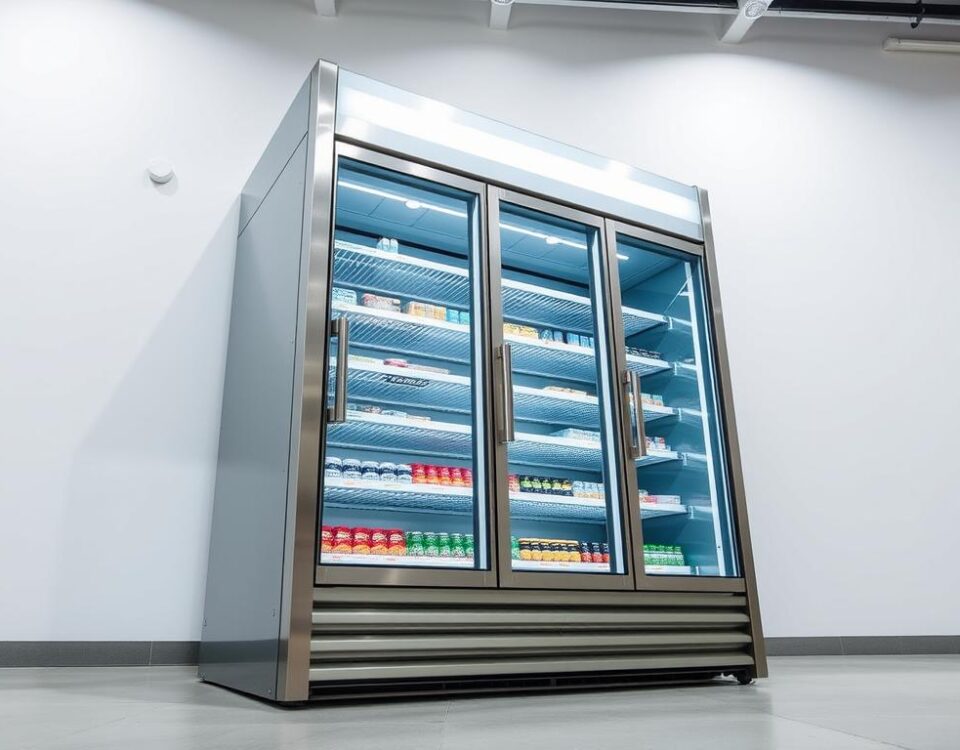
Door-Type vs Conveyor Dishwasher: Speed and Footprint Compared
September 11, 2025
Pitco vs Frymaster: Which Fryer Delivers Crispier Results?
September 13, 2025I still remember the first time I tasted juicy fried chicken cooked in a pressure fryer. The crunch on the outside and the tender meat inside left me wondering what made it so special. A recent poll found that 95 percent of Americans love eating fried chicken, and it’s no surprise why – it’s a culinary delight. What’s surprising is that pressure fryers achieve this at a much lower oil temperature than open fryers, typically between 285°F to 310°F.
Cooking under pressure at lower temperatures results in very moist chicken and longer oil life. So, what makes pressure fryers so effective at retaining moisture? Let’s dive into the science behind it.
Key Takeaways
- Pressure fryers cook chicken at lower oil temperatures, resulting in juicier meat.
- Cooking under pressure retains moisture and extends oil life.
- The science behind pressure frying explains its effectiveness.
- Pressure fryers achieve a perfect balance of crispy exterior and moist interior.
- Restaurants like KFC have relied on pressure fryers for decades.
The Science Behind Pressure Frying
Understanding the science behind pressure frying reveals why it’s superior to traditional frying methods. The key lies in the specialized equipment designed for pressurized cooking.
How Pressure Fryers Work Differently Than Open Fryers
Pressure frying involves using a sealed chamber where steam can’t escape, allowing pressure to build. This results in a lower temperature needed compared to open frying. The pressurized cooking environment traps moisture within the chicken, resulting in juicier meat.
The fundamental difference between pressure fryers and open fryers lies in their cooking process. While open fryers allow moisture to evaporate freely, pressure fryers create a sealed environment that prevents excess oil and moisture loss.
The Physics of Moisture Retention Under Pressure
The increased pressure physically prevents moisture from escaping the chicken during cooking. This process keeps natural juices locked inside, rather than being replaced by oil. The pressure also creates an opposing force against oil penetration, resulting in less oil absorption compared to open frying.
The pressure cooking environment allows for lower cooking temperatures while still achieving proper doneness. This results in more even heat distribution, eliminating cold spots that can affect quality.
Data-Backed Benefits of Pressure Fryer Chicken Quality

Pressure frying has emerged as a superior cooking method, particularly for chicken, with data highlighting its advantages. The science behind pressure frying reveals several key benefits that contribute to its ability to produce high-quality chicken.
Lower Cooking Temperatures: 285°F vs 350°F+
The temperature difference between pressure fryers and open fryers is significant. Pressure fryers operate at a lower temperature range of 285°F to 310°F, compared to the 350°F to 375°F range of open fryers. This lower temperature helps in cooking the chicken more evenly and retaining its moisture.
Faster Cooking Times and Energy Efficiency
Cooking time is significantly reduced with pressure fryers due to the combination of high heat and pressure. This not only results in faster cooking times but also leads to energy efficiency, as the overall energy consumption is lowered due to the shorter cooking duration and lower temperature requirements.
Moisture Retention: The Numbers Don’t Lie
The data on moisture retention is compelling. Pressure frying ensures that the chicken retains more moisture compared to open frying. The pressure prevents the chicken from being saturated with oil, resulting in less fat absorption. Studies have shown that pressure-fried chicken can retain up to 20% more moisture than its open-fried counterpart.
In conclusion, the benefits of pressure frying chicken are multifaceted, including lower cooking temperatures, faster cooking times, and improved moisture retention. These advantages not only contribute to a healthier product with less oil but also enhance the overall quality of the food. As a result, pressure frying is becoming a preferred method for achieving high-quality chicken with significant benefits for both consumers and commercial operators.
My Pressure Frying Technique for Perfect Results
With the right technique and a bit of practice, anyone can master the art of pressure frying chicken to perfection. My journey with pressure frying has been a long one, filled with experimentation and learning. In this section, I’ll share my insights and techniques for achieving consistently delicious results.
Preparation: Setting Up Your Pressure Fryer
Proper preparation is key to successful pressure frying. This begins with setting up your pressure fryer correctly. I always start by selecting the right oil for the job, typically a high-smoke-point oil that can handle the high temperatures involved in pressure frying. Filling the fryer to the correct level is also crucial, as is pre-heating it to the right temperature before adding the chicken.
Key Preparation Steps:
- Choose the right oil for pressure frying
- Fill the fryer to the recommended level
- Pre-heat the fryer to the correct temperature
Temperature and Time: My Proven Settings
Temperature and cooking time are critical factors in achieving perfect pressure-fried chicken. Through trial and error, I’ve developed specific temperature settings for different chicken parts. For instance, chicken wings require a slightly different temperature than breasts or thighs. Adjusting cooking times based on the size of the chicken pieces and the desired level of crispiness is also important.
| Chicken Part | Temperature (°F) | Cooking Time (minutes) |
|---|---|---|
| Wings | 375 | 8-10 |
| Breasts | 350 | 10-12 |
| Thighs | 375 | 9-11 |
Safety Considerations and Best Practices
Safety is paramount when working with hot oil under pressure. Modern pressure fryers come equipped with various safety features, including high-limit thermostats and lid locks that prevent opening before pressure release. It’s also essential to follow best practices such as proper lid locking procedures and regular maintenance of the fryer.

By following these guidelines and practicing your technique, you’ll be well on your way to achieving perfect results with your pressure fryer. Remember, the key to success lies in the details and a commitment to safety.
Conclusion: Why I’ll Never Go Back to Open Frying
The moment I started using a pressure fryer, I knew I would never go back to traditional frying methods again. The benefits of pressure frying are clear: faster cooking times, tenderization, and improved moisture retention, resulting in a crispy crust and a healthier product with less fat.
My experience with pressure fryer chicken quality has been consistently impressive, with noticeable improvements in moisture retention and flavor. I’ve also found that pressure frying has expanded my menu options, allowing me to cook a variety of food items beyond chicken.
The feedback from family, friends, and customers has been overwhelmingly positive, with many commenting on the noticeable difference in my pressure-fried chicken. While the initial investment in a pressure fryer may seem significant, the long-term benefits in food quality, oil savings, and energy efficiency make it a worthwhile investment for any serious commercial kitchen or home cook.
In conclusion, I highly recommend making the switch to pressure frying for anyone looking to elevate their cooking results. With its numerous benefits and consistent quality, it’s an essential equipment for any kitchen that prioritizes chicken quality.
FAQ
How does a pressure fryer compare to an open fryer in terms of oil usage?
I find that pressure fryers use less oil than open fryers, resulting in a healthier product with less waste. This is because the food is cooked in a sealed environment, reducing the amount of oil that’s absorbed.
What are the benefits of cooking with a pressure fryer?
Cooking with a pressure fryer has several benefits, including faster cooking times, energy efficiency, and moisture retention. This results in a more tender and juicy final product that’s full of natural juices.
How do I care for my pressure fryer to ensure optimal performance?
To keep my pressure fryer in top condition, I make sure to regularly clean and maintain the equipment, paying close attention to the seals and other critical parts. This ensures that my fryer continues to produce high-quality results.
Can I use a pressure fryer for menu items beyond fried foods?
While pressure fryers are ideal for cooking fried foods, I also use mine to prepare a variety of other menu items, such as cooking certain meat and vegetable dishes. The versatility of the pressure fryer makes it a valuable addition to any commercial kitchen.
How do I achieve the perfect cooking time and temperature in my pressure fryer?
To achieve perfect results, I carefully control the cooking time and temperature in my pressure fryer. By following established guidelines and using the right settings, I can ensure that my dishes turn out perfectly cooked every time.
Are pressure fryers more cost-effective than traditional frying methods?
In my experience, pressure fryers can be more cost-effective than traditional frying methods, as they use less oil and energy. This can lead to significant cost savings over time, making them a smart investment for any restaurant or food service operation.



